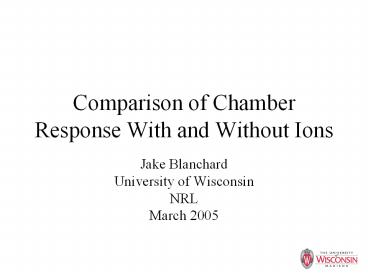Comparison of Chamber Response With and Without Ions - PowerPoint PPT Presentation
1 / 24
Title:
Comparison of Chamber Response With and Without Ions
Description:
Comparison of Chamber Response With and Without Ions. Jake Blanchard. University of Wisconsin ... Energy per pulse is less than 5% of total ion and x-ray energy ... – PowerPoint PPT presentation
Number of Views:33
Avg rating:3.0/5.0
Title: Comparison of Chamber Response With and Without Ions
1
Comparison of Chamber Response With and Without
Ions
- Jake Blanchard
- University of Wisconsin
- NRL
- March 2005
2
Summary of Previous Analysis
- Assume no magnetic deflection
- Perkins spectra
- Chamber wall is dry tungsten coated ferritic
steel - Look at temperatures, stresses, strains, fatigue,
and fracture
3
Temperatures
- 154 MJ
- 7 m
- 250 microns tungsten
- 3 mm steel
4
Strains
- Peak strains are gt1
- Effective strains are gt2
5
Stress/Strain Behavior
6
Fatigue Data for Stress-Relieved Tungsten
Cracking is expected in hundreds to thousands of
cycles
Pure W, 815 and 1232 C
7
Fracture Mechanics Analysis Results 250 microns
W 7 m Chamber 154 MJ Target
Min toughness for W below 600 K
- Stress intensity decreases with crack
depthCracks may arrest, if coating is thick
enough
1 mm crack spacing
8
Crack Growth
9
More Crack Growth Data
Polycrystalline alumina
10
More Crack Growth Data
11
Fracture Mechanics Analysis Results 250 microns
W 7 m Chamber 154 MJ Target
- Stress intensity decreases with crack
depthCracks may arrest, if coating is thick
enough
Threshold (assume toughness/10)
12
Temperatures in Steel
- 7 m, 154 MJ, 250 microns W
- Swing can be small with sufficiently thick
coating - Stresses are under ASME and fatigue limits
13
Intermediate Conclusions
- Cracking is inevitable
- Cracks may well arrest before reaching steel
- Uncertainties
- Roughening issues
- Other ion effects (blistering, etc.)
- Radiation damage
- Tungsten properties
- X-ray propagation down cracks
- Is threat well characterized?
- Do we have enough margin?
14
Impact of Diverting Ions
- Diversion of the ions will reduce the impact on
the first wall - Just having x-rays opens up the possibility of
using different materials to spread heat over
larger volume - Consider silicon carbide and boron carbide
- Assume 1 ns deposition time (uniform heating)
- Low energy ions might not be diverted
15
Comparison of Attenuation
Material Attenuation Coefficient (/cm at 5 keV) Coating Thickness (microns)
Tungsten 10,700 250
Silicon Carbide 637 800
Boron Carbide 29 1200
http//atom.kaeri.re.kr/cgi-bin/w3estar
16
First Wall Temperature Rise from X-Ray Heating
Only
400 MJ target yield Constant properties
17
First Wall Temperature Rise from X-Ray Heating
Only
Radius6.5 m
18
Peak Stresses in Coatings
- Peak stresses in coatings (400 MJ, 6.5 m)
- Silicon Carbide 25 MPa (bulk strength 500 MPa)
- Boron Carbide 145 MPa (bulk strength 150 MPa)
- Residual stresses from fabrication are key
- Fracture analyses are needed
19
Stress-Strain Behavior (W/154/6.5)
20
Fatigue Data for Stress-Relieved Tungsten
Pure W, 815 and 1232 C
With ions 600 cycles 154 MJ/7 m
Without ions 3,000 cycles 350 MJ/6.5 m
Without ions 20,000 cycles 154 MJ/6.5 m
21
Effect on Substrate
- Energy per pulse is less than 5 of total ion and
x-ray energy - Hence, substrate effects are minimal
- For 400 MJ yield and 6.5 m radius, temperature
rises and stresses in the steel are less than 10
degrees and 15 MPa - Steel fatigue strength is well over 100 MPa
22
Low Energy Ions
- What if ions below 20 keV are not diverted
- Less than 0.4 of debris ion energy is in ions
below 20 keV - For 400 MJ yield, assuming 13 of energy is in
debris ions, even depositing 0.4 of that on
surface in 2 microseconds would cause less than
20 degree rise in tungsten
23
Tests
- Start samples at 600 C
- Run for as many cycles as is reasonable
- Characterization as usual
- Achieve peak temperatures of
- Silicon Carbide 750, 900 C
- Boron Carbide 650, 700 C
24
Conclusions
- The load on the chamber is substantially reduced
if the ions end up elsewhere - The question would be how much we wanted to push
it by going to an even smaller chamber































